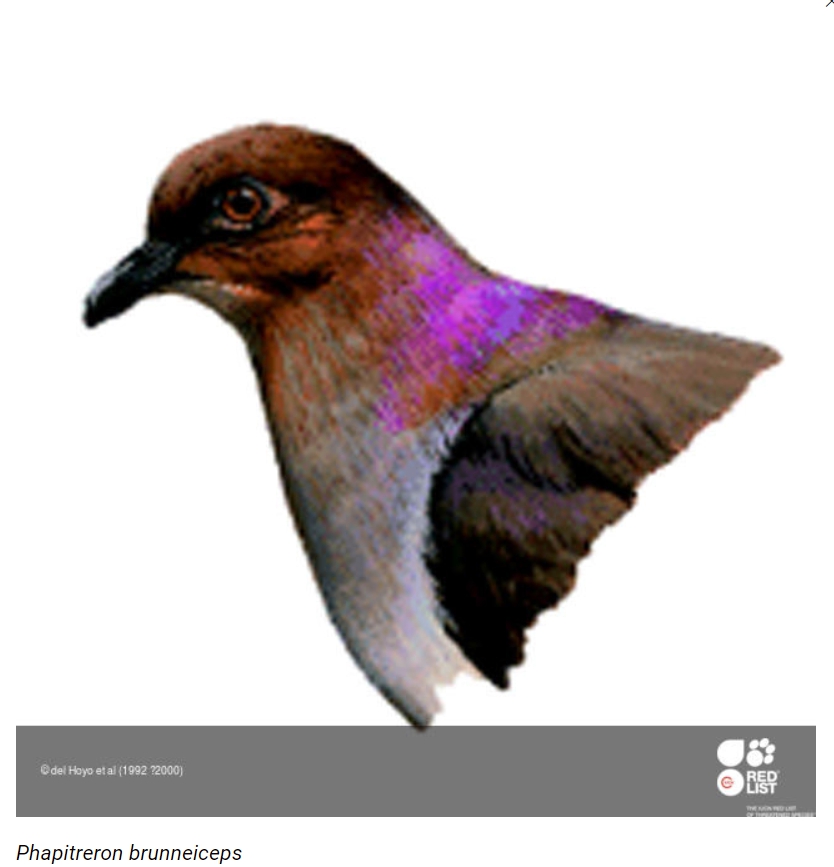| Citation |
BirdLife International. 2016. Phapitreron brunneiceps. The IUCN Red List of Threatened Species 2016: e.T22724523A94870482. https://dx.doi.org/10.2305/IUCN.UK.2016-3.RLTS.T22724523A94870482.en. Accessed on 02 May 2022. Brinkman, J.J., van der Ven, W., Allen, D., Hutchinson, R., Jensen, A.E., Perez, C. (2021): Checklist of birds of the Philippines. Wild Bird Club of the Philippines. www.birdwatch.ph |
Description |
JUSTIFICATION
This species is undergoing a continuing rapid decline owing to widespread reduction in forest cover within its range, and it is now assumed to have a small population that is becoming increasingly severely fragmented. It therefore qualifies as Vulnerable.
RANGE DESCRIPTION
Phapitreron brunneiceps is endemic to the islands of Mindanao and Basilan in the Philippines, where it is known from 10 localities on Mindanao and three on Basilan (Collar et al. 1999). During bird surveys from 2005 to 2007 in Eastern Mindanao, the species was encountered only twice: once at Mount Hilong-hilong (a single specimen was netted) and once at Mount Tagub-Kampalili, both in montane forests above 1,200 m (J. Ibanez in litt. 2007). In 2008 however, the species had the highest relative abundance among threatened Mindanao-endemics on Mount Hilong-hilong (Paz et al. 2013) and is now photographed regularly in the area (D. Allen in litt. 2016). Recent records include those from Zamboanga (per D. Allen in litt. 2012) and Compostella Valley (R. Hutchinson in litt. 2016). It has not been recorded on Basilan since 1937. Its status is considered at best uncommon and at worst extremely rare, although its unobtrusive nature coupled with problems of field separation from P. amethystina may partially impede an accurate assessment.
DESCRIPTION
The population size is preliminarily estimated to fall into the band 2,500-9,999 mature individuals. This equates to 3,750-14,999 individuals in total, rounded here to 3,500-15,000 individuals.
Trend Justification: Intensive hunting pressure and on-going habitat loss are suspected to be driving a rapid population reduction in this species.
HABITAT AND ECOLOGY
It inhabits lowland, hill and lower montane forests up to 1,500 m, occupying a similar ecological niche to P. amethystina, and any factors separating the two species are not yet known. It is not clear if the species makes seasonal or altitudinal movements, but both are considered likely on a local scale.
THREATS
Deforestation, and intensive hunting are the main threats. Illegal logging is not as rampant at high elevations, because most trees are not commercially valuable (J. Ibanez in litt. 2007). In addition, high elevation mountains, at least in eastern Mindanao, are steep, thus they are not threatened by agriculture (J. Ibanez in litt. 2007). However, mining is a present threat as there are current explorations in high elevation areas. For example, a proposed mineral reservation at the heart of the proposed Mount Tagub-Kampalili Protected Landscape (Davao Oriental and Compostela Valley Province) has been given clearance by communities and local government units (J. Ibanez in litt. 2007). Similar open-pit chromite and nickel mining reservations are also being proposed in areas along the eastern Mindanao mountains (J. Ibanez in litt. 2007). Just 29% of Mindanao remained forested in 1988 (now considered a considerable overestimate). Almost all forest below 1,200 m has been felled at Mt Kitanglad. On Basilan, logging operations in the 1960s, followed by clearance for agriculture and increased hunting, have undoubtedly affected the species, but security concerns have prevented surveys that could verify this (D. Allen in litt. 2012).
CONSERVATION ACTIONS
Conservation Actions Underway
There are recent records from one protected area, Mt Kitanglad Natural Park, and older records derive from areas now within the Mt Apo Natural Park, Mt Malindang National Park, Mt Matutum Forest Reserve (proposed as a national park) and Mt Hilong-hilong Watershed Reserve. Basilan is ostensibly a national park, but lacks effective protection.
Conservation Actions Proposed
Conduct fieldwork to assess abundance, elevational range and habitat requirements at key sites. Carry out surveys to assess whether the species is (still) present in poorly surveyed areas of Mindanao (e.g. Mts Hilong-hilong, Matutum, Mayo and Three Kings). Ensure the effective protection of remaining forest at (possible) key sites. |

